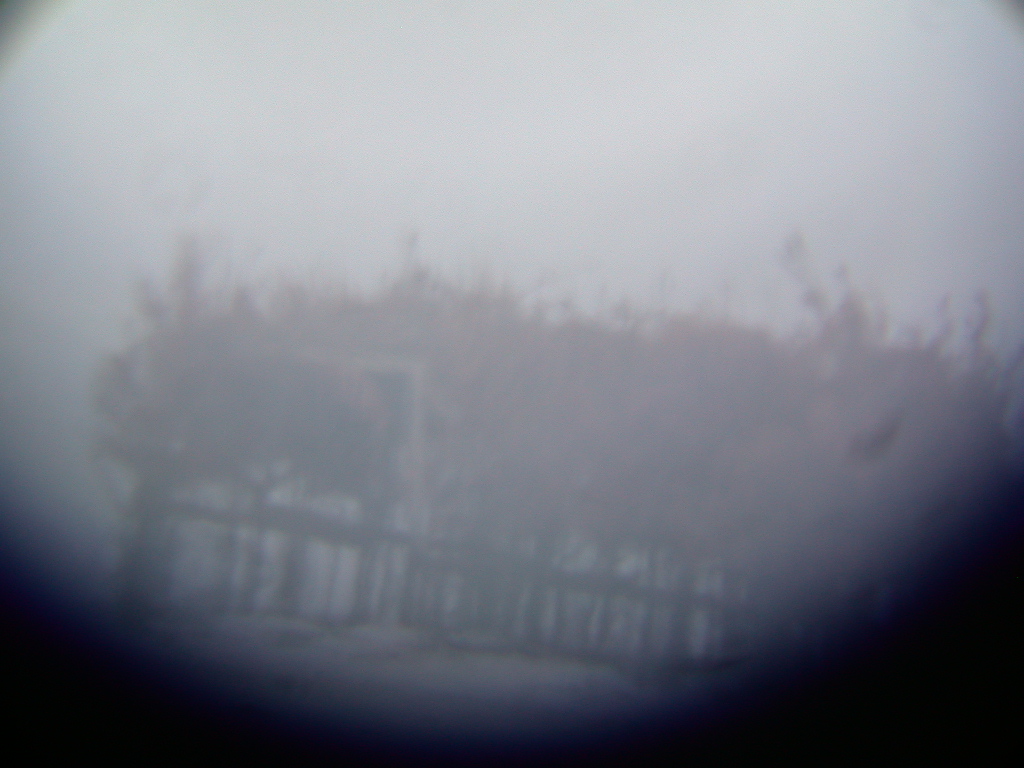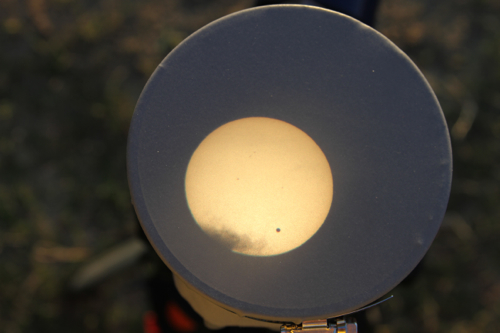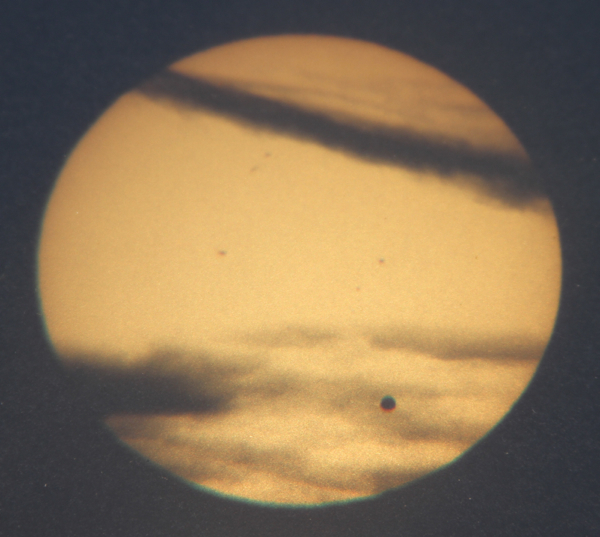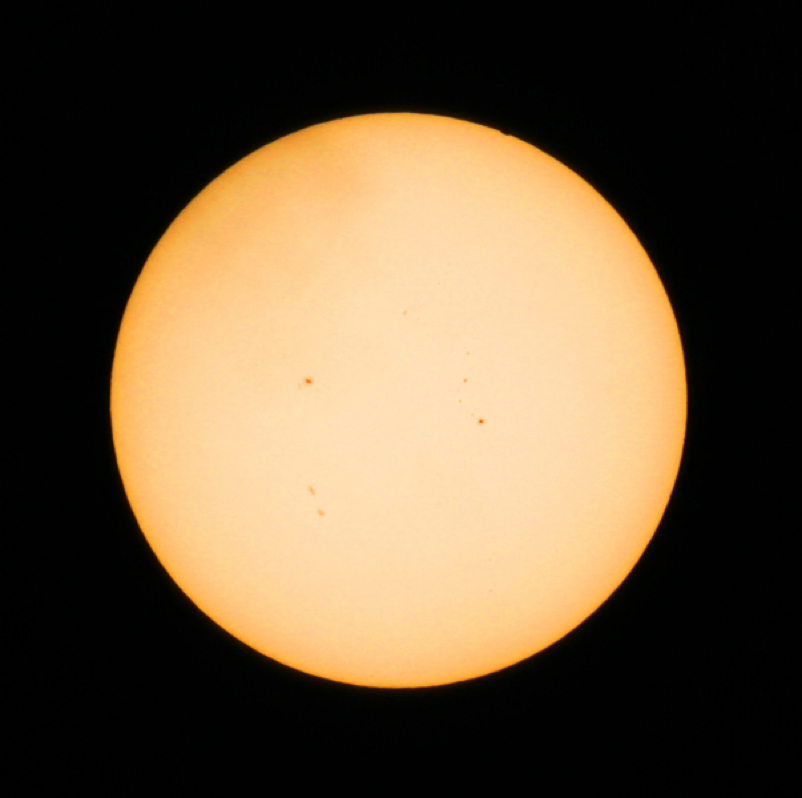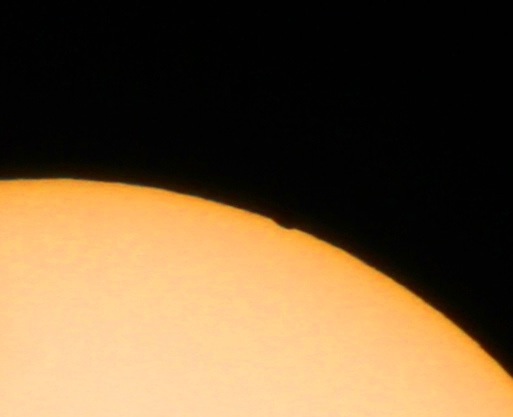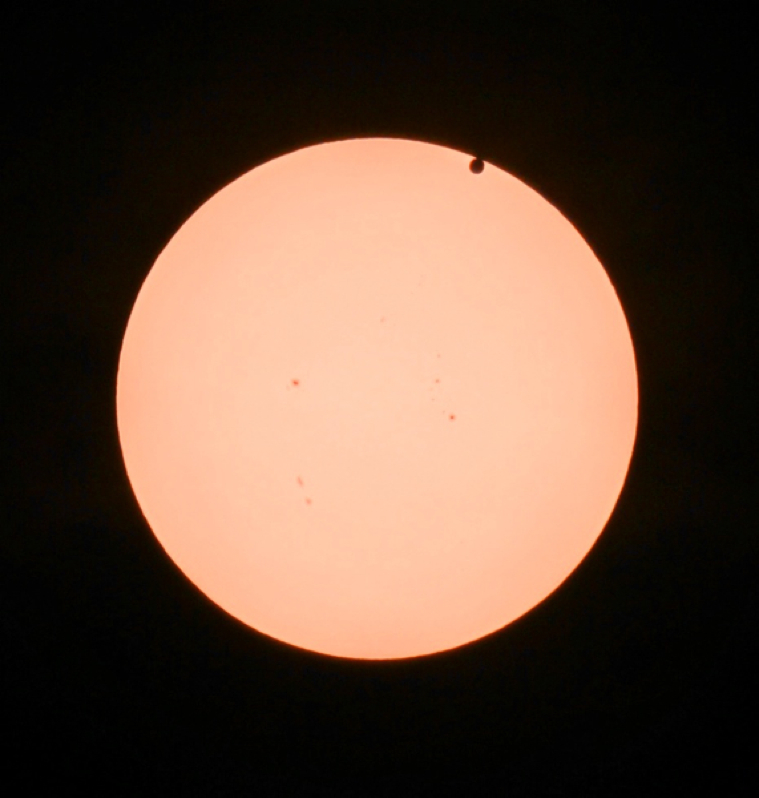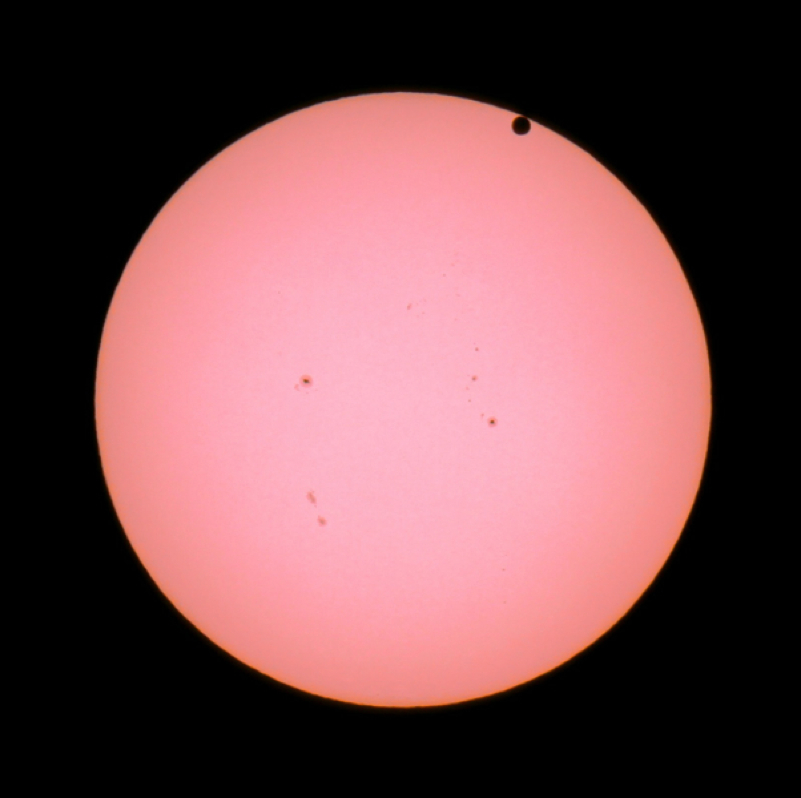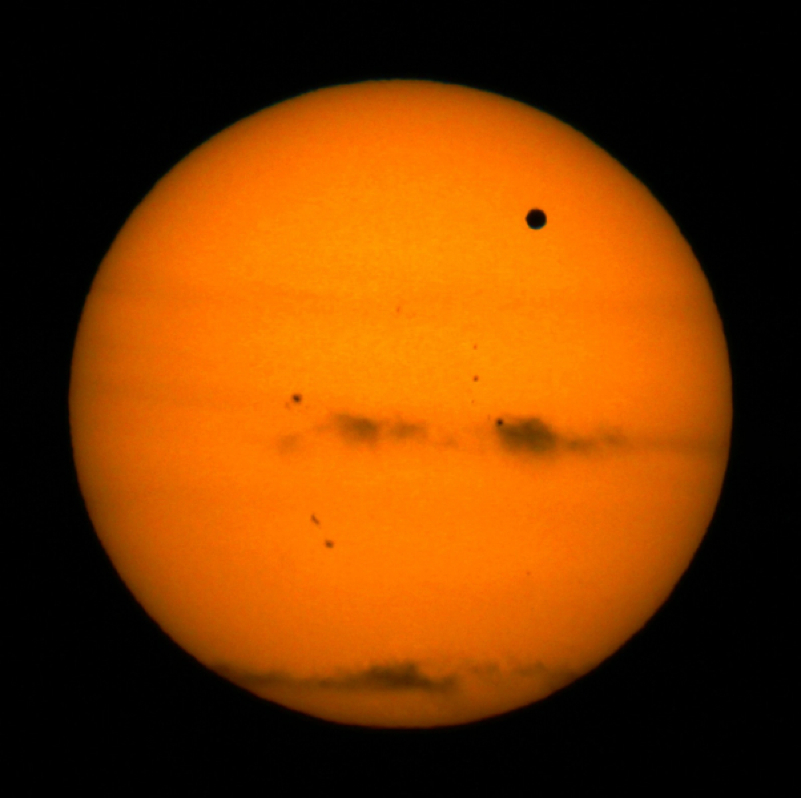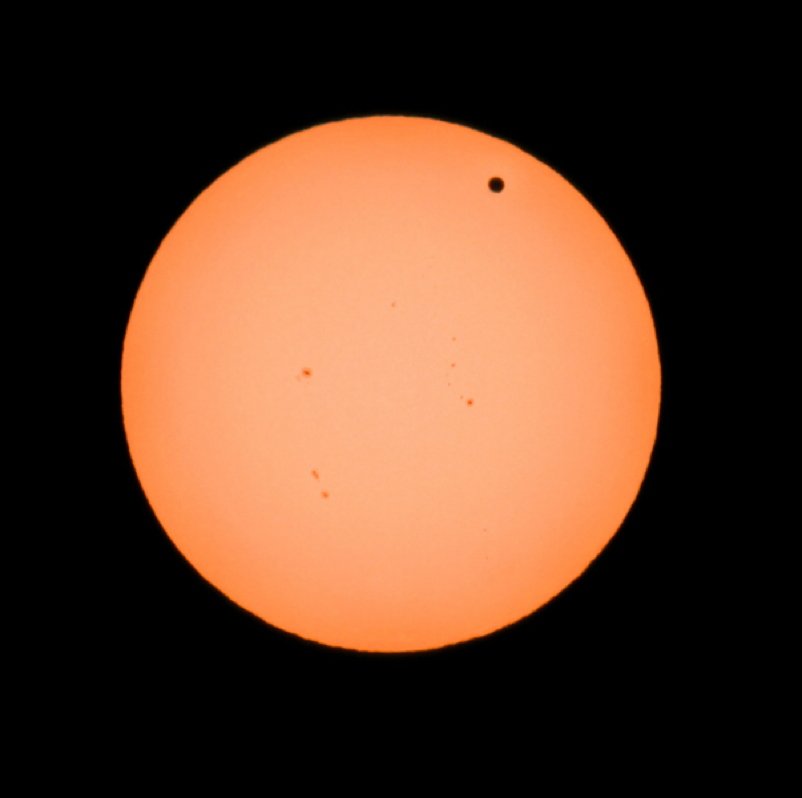|
I
initially became interested in observing a Venus Transit back in 2004
when the first Venus transit of this century occurred. I had
recently joined the Back Bay Amateur Astronomers in January after my
re-introduction to astronomy on Christmas of 2003. Some members
of the club were going to try and observe the transit at the Virginia
Beach ocean front and another group was going to try to observe it from
a boat launch in Back Bay which was about a dozen miles south of the
other group. I remember showing up early with my trusty Meade
LX-200 10” telescope with a handmade solar filter. I was planning
on trying to capture the event with my trusty digital camera. We
met up at BBAA member Mark Ost’s house, who lives but a hop, skip and a jump
from the boat ramp. Once assembled, we all loaded up in our
vehicles and went down to the boat ramp. The sky was a pretty
cloudy, but we had high hopes that the clouds would dissipate for
us. I set up my LX200 and did a “dummy alignment" eventually pointing it
towards the horizon to await sunrise. We waited diligently for the
clouds to part, yet they decided not to cooperate and we remained under
a veil of clouds the entire time, our entire group missed out on the 2004 Venus
transit. I did however get a nice image of a duck blind across
the bay while we were waiting.
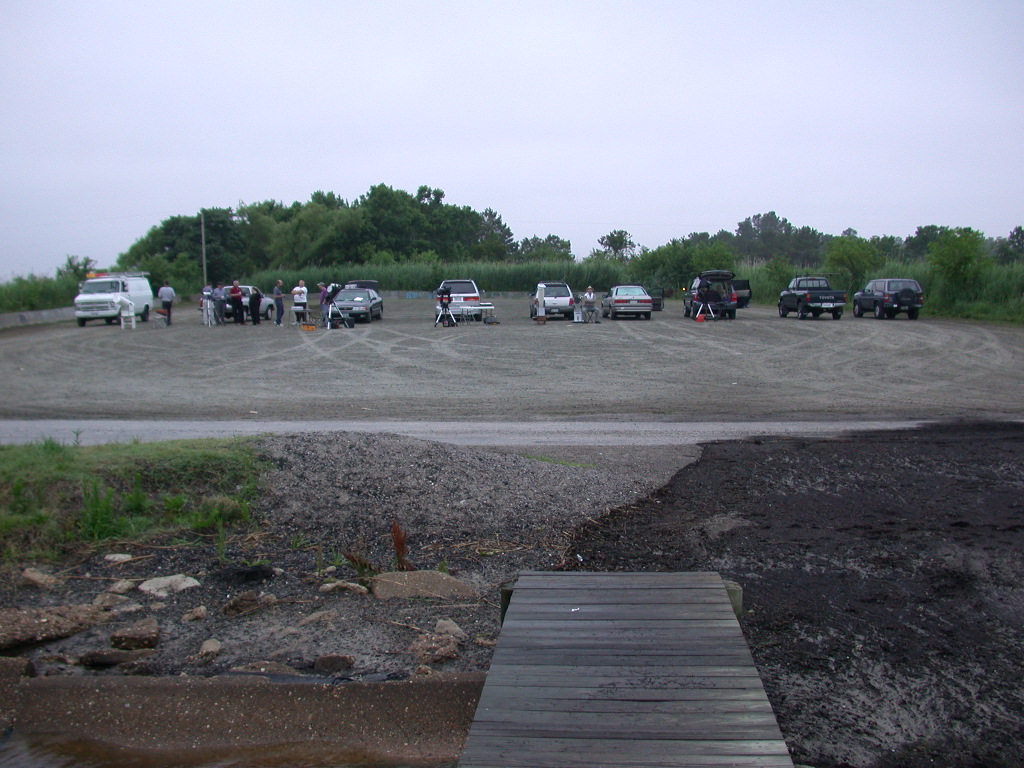 2004 Venus Transit Hopefulls 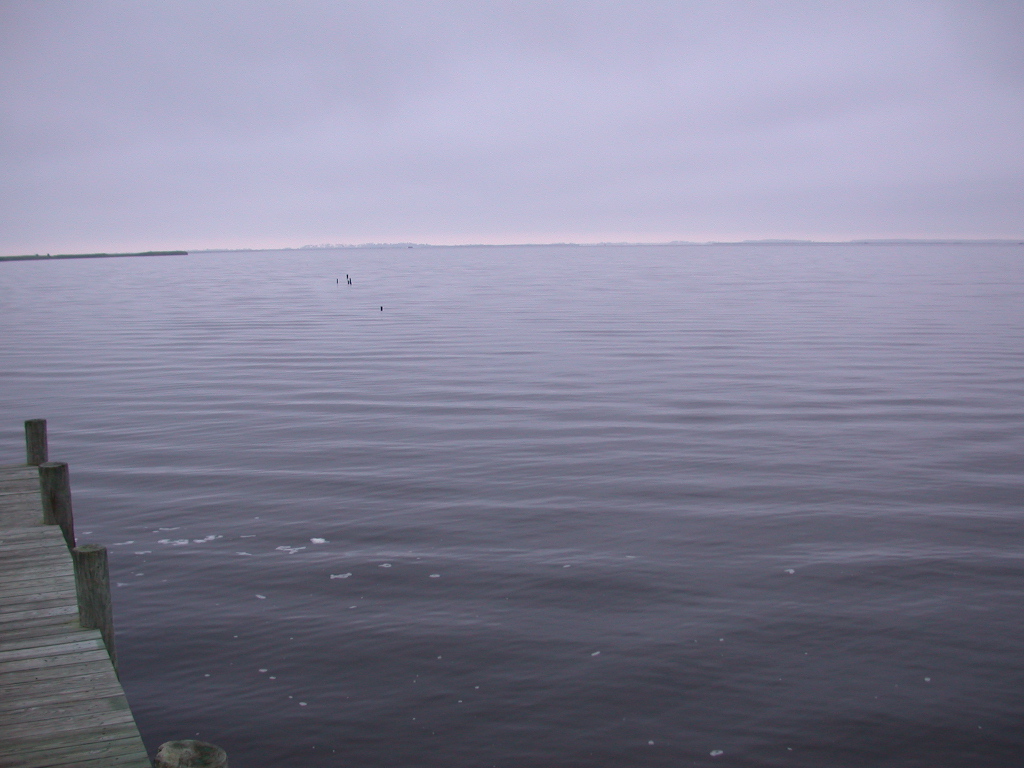 2004 Venus Transit Horizon at 1st Contact
2004
Venus Transit Duck Blind
The club’s other group which met at the Virginia Beach ocean front fared much better. The clouds opened enough for them so they were able to see some of the transit. Their only problem was that they had parked at the ocean front about a half hour before it was “legal” (don’t ask, a stupid Virginia Beach ordinance) so they all merrily received invitations to traffic court for parking violations, I thought it would have been a small price to pay. It was at this time I began setting my sights on the next Venus Transit in June of 2012, eight years into the future, a long wait ensued. I began preparing in earnest for the 2012 Venus Transit in early April of 2012. I began practicing setting up my imaging and viewing equipment almost every weekend that the sun was out. The equipment consisted of our SolarMax 60mm hydrogen alpha refractor telescope to observe in the HA spectrum and an Orion 80 mm ED refractor telescope fitted with a Thousand Oaks white light glass solar filter. The Orion was providing some very good views of the sun and allowing me to practice taking images with my digital SLR camera. My first encounter with Murphy occurred one weekend in early May, I inadvertently slewed my telescope in such a manner that the Thousand Oaks glass solar filter fell from the objective of the telescope and shattered into about a thousand pieces on my driveway. I immediately began the quest to acquire a replacement filter, let me tell you that by this time EVERYONE was trying to acquire solar filters for both the upcoming eclipse event and the Venus transit. As luck would have it, I managed to finally contact a vendor that had a single Baeder film filter remaining in stock and I yanked the plastic out of my wallet as fast as I could to acquire it. During this period I also learned of a new way to observe the sun with a small aperture telescope without any special solar filters. A derivative of the projection method that projects the sun’s image onto a piece of white paper or white card stock. This new method involved taking a plastic, long necked funnel and modifying it to accept a10-20 mm plossl eyepiece in the narrow end and then stretching rear projection material across the wide end, the eyepiece and projection material secured in place with common hose clamps, it was called a solar funnel. I acquired the materials to make a couple of these solar funnels and I was amazed at the clarity and detail the projection produced. The endearing quality of the solar funnel is that it allows more than one individual to observe the sun at a time. So I built one of the solar funnels with an adjustable plossl eyepiece and set it up on my original Meade ETX-70 scope. In order to convince the Meade ETX Autostar logic to follow the sun, I had to add an asteroid object with the same orbital information as the sun. This worked very well. So my equipment count was up to three telescopes across two mounts. The iOptron mini-tower would provide the mount for the SolarMax 60 and the Orion 80 ED telescopes. Murphy next appearance was just three weeks before the transit, the iOptron mount started complaining of motor errors in first the RA motion and then also in the DEC motion. Consultation with iOptron technicians yielded three possible culprits a bad motor, a bad sensor assembly or a bad main circuit card. With time of the essence, I ordered one of each in an effort to ensure the mount was fully operational. Good thing I ordered all three, as the DEC motor required replacement, the RA motor sensor ended up being bad and there was a blown capacitor on the main circuit board so all three parts were replaced bringing the iOptron mount back to snuff. With ten days until the transit I wondered what next would go wrong. I had been scouting out potential transit viewing locations during the weekends leading up to June 5th. At the top of the list was a park in Newport News at the Eastern entrance to the James River Bridge. Second was atop Mount Trashmore in Virginia Beach. The third was on an airport access road around the perimeter of the Chesapeake municipal airport. I had visited each of the sites on weekends before the transit. The Newport News site had the best Western horizon with the Mount Trashmore coming in second. However I was leaning away from Mount Trashmore because I did not embrace the vision me humping ALL of my gear up to the top of that big hill. The airport site was scrapped because I was not able to acquire access/use permission. So it was Newport News or nothing. Murphy’s next entrance came as a result of my “cat-like” (read that “sloth-like”) reflexes to vehicles abruptly stopping to allow a gaggle of geese to cross Volvo Parkway, I could not stop in time and plowed my beloved Honda Pilot into another vehicle – amazing what you think of while the airbag is deploying. I was thinking what will I use for the Venus transit? Much to the chagrin of my wife, the Pilot would be out of commission for three weeks so I would have to squeeze all of my telescope equipment into her Honda CRV. I awoke the morning of the transit to a cloudy and rainy sky, I began scouring the weather forecasts for our area and everywhere I could think of within about six hours driving time. I found the same basic forecast everywhere. There were but two exceptions, the NOAA weather forecast suggested a possible clearing in Newport News a couple of hours before sunset and the other forecast was the Clear Sky Chart from Atillo Danko. Atillo’s forecasting algorithms predicted clear skies around sunset for most of our area including the Newport News site. I went ahead and loaded up What’s Her Name’s CRV with all of the equipment and spares for this and that. I donned my bright yellow Vensu Transit T-shirt and went to pluck my ten year old grandson Cameron out of school. After Cameron donned his Venus Transit T-Shirt we were off to another BBAA club member’s house to drive to the Newport News site together. We arrived in Newport News at the park/beach to a very dark and drizzly sky. 2012
Venus Transit Initial Sky @ 3:30 PM
2012
Venus TransitSkyline @ 3:30 PM
We opted to go have a short lunch before setting up any equipment. After munching on cheese fries and mozzarella sticks we trundled back in the drizzle to our cars where we waited for the rain to stop. After about 15 minutes the drizzle and rain stopped and Jim and I began taking our equipment out and setting up. Cameron wandered around on the beach playing in the sand. Cameron
in the yellow shirt playing on the beach
Murphy couldn’t stand to just let the dismal weather be our only issue, to my horror I discovered that I had left the power cable for the iOptron mount and the data transfer cable for my digital SLR camera at home. I was all set to drive all the way home and find my cords when my buddy Jim provided a spare power cord that would fit the iOptron mount, I then remembered that I brought a backup DSLR camera and in that case there was a data transfer cable so my last encounter with Murphy was quickly solved. Once we had everything out and setup, again came the rain and we covered everything we could and quickly put other things back into our vehicles. This rain was also short lived and we were able to get everything back out by four o’clock. Jim
with his Venus Transit Shirt
Jim's
VT Rig
HA
rig on the left and imaging rig on the right on the iOptron mount
By four thirty, some of the Virginia Peninsula Astronomy Society, VPAS, members began showing up, everyone hoping the weather would clear. At about five twenty, the clouds began breaking up and the sun began shining through sucker holes. The sucker holes provided enough time for us all to get our equipment lined up and ready, then the clouds swallowed up the holes as quickly as they had opened them. Bird
Taylor, our gracious VPAS host with ONE of his rigs
Another
Happy Venus Transit Observor,Nice Shirt!
Bill
and his wife, where is Bill's Scope?
VPAS
Group picture-1
VPAS
Group picture-2
VPAS
Group picture-3
VPAS
Group picture-4
Then as if on cue, at about six o’clock the skies opened back up and we were able to see the sun again. Final adjustments to alignment and focus were made until right at about 6:05 PM when the Venus transit commenced. All across the beach, indiscriminate hoops of enthusiasm were shouted out until the clouds took the view away again for a few moments. At about 6:12 PM the skies parted once again and we were able to observe the Drop-Effect and Second Contact, where the dark disk of Venus is fully engaged within the sun. I was snapping pictures with my Canon 7D digital SLR camera and people were clamoring to view the event at any available telescope. The surprising big hit was our solar funnel, it allowed multitudes of folks to actually take a picture with their cell phones as Venus moved slowly across the sun. THE
AMAZING SOLAR FUNNEL PROJECTION!
Another
View of the Solar Funnel
Cloudy
Solar Funnel View
Cameron
manning the Solar Funnel
I went around to nearly every telescope on the beach and viewed the spectacle through each one. There were scopes ranging in aperture from 2” up to 14” pointed at the transit, and every view just about the same while each being unique. Finally around 8:20 the clouds once again crept up and removed this once in a life opportunity from us. But not after each and every soul on the beach felt satisfied in their quest to observe the last Venus transit of our lives. My grandson Cameron and I packed up the Honda and managed to say our goodbyes and get home by 9:30, after a quick stop into McDonalds which served as our evening meal. I honestly feel that the Venus transit was the second most memorable viewing of my life, right after watching Neil hop off of that ladder in July of 1969. The following images reflect the best of the 350+ images I took, please enjoy them!
First
Contact 06:05 EDT
First
Contact Enlarged
The
"drop" effect 06:21 EDT
Second
Contact 06:23 EDT
VT
with Clouds Coming In about 7:49 PM EDT
Last
Decent Image Taken about 7:47 PM
EDT
|
